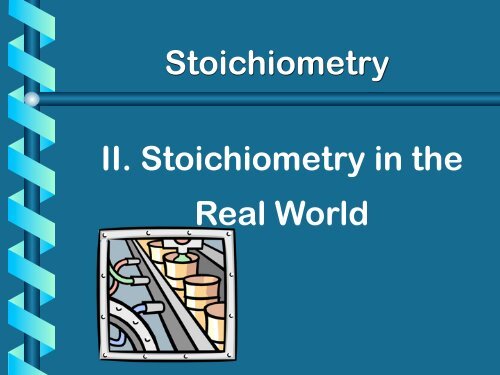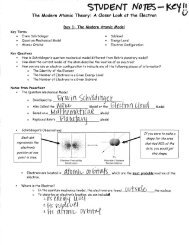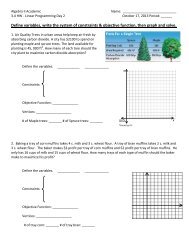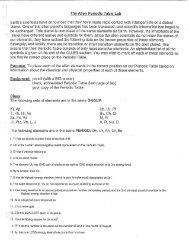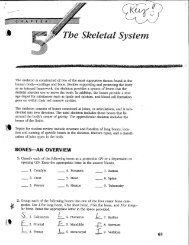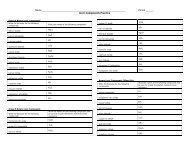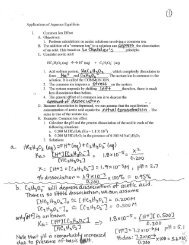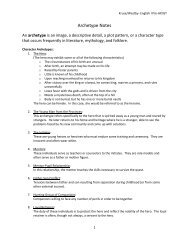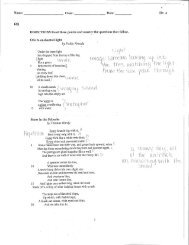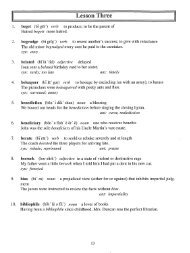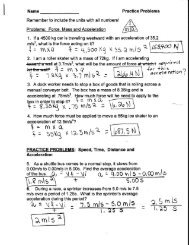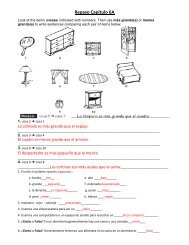B. Limiting Reactants
B. Limiting Reactants
B. Limiting Reactants
Create successful ePaper yourself
Turn your PDF publications into a flip-book with our unique Google optimized e-Paper software.
A. <strong>Limiting</strong> <strong>Reactants</strong><br />
b <strong>Limiting</strong> Reactant<br />
• used up in a reaction<br />
• determines the amount of<br />
product<br />
b Excess Reactant<br />
• added to ensure that the other<br />
reactant is completely used up<br />
• cheaper & easier to recycle
A. <strong>Limiting</strong> <strong>Reactants</strong><br />
b An analogy: Peanut Butter &<br />
Jelly Sandwiches<br />
b Available Ingredients<br />
• 4 slices of bread<br />
• 1 jar of peanut butter<br />
• 1/2 jar of jelly
A. <strong>Limiting</strong> <strong>Reactants</strong><br />
b Peanut Butter & Jelly Equation<br />
b 4 bread slices + 1 jar of peanut<br />
butter + 1/2 jar of jelly ------> 2<br />
sandwiches<br />
b <strong>Limiting</strong> Reactant<br />
• bread (only 2 sandwiches can be<br />
made)<br />
bExcess <strong>Reactants</strong><br />
• peanut butter and jelly
B. <strong>Limiting</strong> <strong>Reactants</strong> - Example<br />
23.10g of Al metal is dissolved in 68.80g<br />
of HCl. How many grams of hydrogen<br />
gas are produced?<br />
Step 1: Write a balanced equation.<br />
2Al + 6HCl ! 2AlCl 3 + 3H 2<br />
23.10g ? g<br />
68.80 g
B. <strong>Limiting</strong> <strong>Reactants</strong> - Example<br />
Step 2: Determine which reactant will limit the<br />
amount of products made.<br />
• Pick one of the reactants.<br />
• Convert it to find the amount of the other reactant<br />
needed.<br />
• Compare amount of reactant needed to amount of<br />
reactant given.<br />
• If amt. of reactant needed > amt. of reactant given<br />
= <strong>Limiting</strong> Reactant<br />
• If amt. of reactant needed < amt. of reactant given<br />
= Excess Reactant
B. <strong>Limiting</strong> <strong>Reactants</strong> - Example<br />
LR=limiting reactant<br />
2Al + 6HCl ! 2AlCl 3 + 3H 2<br />
23.10g 68.80 g<br />
? g<br />
* We chose to start with Al and convert to HCl needed to use all of the Al up<br />
in the rxn.<br />
23.10<br />
g Al<br />
1 mol<br />
Al<br />
26.98<br />
g Al<br />
6 mol<br />
HCl<br />
2 mol<br />
Al<br />
36.48 g<br />
HCl<br />
1 mol<br />
HCl<br />
= 93.65 g<br />
HCl<br />
needed<br />
But you only have 68.80 g, so you don’t have enough HCl to<br />
use all of the aluminum. HCl is the limiting reactant!
B. <strong>Limiting</strong> <strong>Reactants</strong> - Example<br />
Step 3: Solve the question in the problem. Always<br />
start with the given for the <strong>Limiting</strong> reactant.<br />
How many grams of hydrogen will be produced? The amount is<br />
determined by the limiting reactant, since we run out of that<br />
reactant first. LR<br />
2Al + 6HCl ! 2AlCl 3 + 3H 2<br />
23.10g 68.80 g<br />
? g<br />
68.80<br />
g HCl<br />
1 mol<br />
HCl<br />
36.46<br />
g HCl<br />
3 mol<br />
H 2<br />
6 mol<br />
HCl<br />
2.02 g<br />
H 2<br />
1 mol<br />
H 2<br />
= 1.906 g<br />
H 2<br />
produced
B. <strong>Limiting</strong> <strong>Reactants</strong> - Example<br />
Product Formed:<br />
<strong>Limiting</strong> reactant: HCl<br />
Excess reactant: Al<br />
How many grams of<br />
left over aluminum?<br />
1.906 g H 2
B. <strong>Limiting</strong> <strong>Reactants</strong> - Example<br />
Step 4: Determine the amount of excess reactant<br />
left after reacting with the limiting reactant.<br />
• Start with the limiting reactant!<br />
• Convert to the quantity of the OTHER reactant, the<br />
excess reactant, to find the needed amount.<br />
• Amt. of excess reactant left =<br />
(given amt. of excess) - (needed amt. of excess)
B. <strong>Limiting</strong> <strong>Reactants</strong> - Example<br />
ER=excess reactant<br />
LR<br />
2Al + 6HCl ! 2AlCl + 3H 3 2<br />
23.10g 68.80 g<br />
? g<br />
68.80<br />
g HCl<br />
1 mol<br />
HCl<br />
36.46 g<br />
HCl<br />
2 mol<br />
Al<br />
6 mol<br />
HCl<br />
26.98 g<br />
Al<br />
1 mol<br />
Al<br />
But you have 23.10 g of Al, so :<br />
= 16.97 g<br />
Al<br />
used<br />
(23.10g given) – (16.97g used/needed) = 6.13 g<br />
unused excess reactant
B. <strong>Limiting</strong> <strong>Reactants</strong> - Example 2<br />
b Methane gas and hydrogen disulfide<br />
gas form when hydrogen gas and<br />
carbon disulfide react.<br />
3H 2 + CS 2 ! CH 4 + H 2 S 2<br />
36.0 L 12.0 L<br />
(a) Identify the limiting and excess<br />
reactants<br />
(b) Calculate how much of the excess<br />
reactant remains after the reaction.
B. <strong>Limiting</strong> <strong>Reactants</strong> - Example 2<br />
36.0 L<br />
H 2<br />
3H 2 + CS 2 ! CH 4 + H 2 S 2<br />
36.0 L 14.4 L<br />
1 L<br />
CS 2<br />
3 L<br />
* Booklet should read given as 14.4 L CS2<br />
instead of 12.0 L<br />
* Since this is a Volume - Volume<br />
problem, we can substitute the<br />
mole ratio for the “liter ratio”<br />
= 12.0 L CS 2 needed to<br />
react with all of the H 2 .<br />
H 2 We have 14.4L CS 2 .<br />
It is the excess reactant.<br />
H2 is limiting.
A. Percent Yield - Definition<br />
•Measures the efficiency<br />
of the reaction.<br />
•Ratio of the actual yield<br />
to the theoretical yield.<br />
•Expressed as a percent<br />
%.
B. Percent Yield - Formula<br />
measured in lab<br />
calculated on paper
C. Percent Yield - Example<br />
24.8 g of calcium carbonate are<br />
heated to yield 13.1 g of calcium<br />
oxide. What is the percent yield<br />
of calcium oxide?<br />
24.8 g 13.1g<br />
CaCO 3 ! CaO + CO 2<br />
actual: 13.1 g
C. Percent Yield - Example<br />
24.8 g<br />
CaCO 3<br />
CaCO 3 ! CaO + CO 2<br />
24.8 g ? g<br />
actual: 13.1 g<br />
Theoretical Yield: g of reactant to g<br />
of CaO<br />
1 mol<br />
CaCO 3<br />
100.08 g<br />
CaCO 3<br />
1 mol<br />
CaO<br />
1 mol<br />
CaCO 3<br />
56.04<br />
CaO<br />
= 13.9<br />
1 mol g CaO<br />
CaO
C. Percent Yield - Example<br />
Theoretical Yield = 13.9 g CaO<br />
% Yield =<br />
CaCO ! CaO + CO 3 2<br />
24.8 g 13.9 g<br />
actual: 13.1 g<br />
13.1 g<br />
13.9 g<br />
" 100 = 94.2%


